CHACONNE
Revived the Stradivari in the present era

Even today, nearly 300 years later the famous old Italian violins including Stradivari have exquisite performance qualities overshadowing any other instruments. Why do they sound so good? Hirokazu Kubota, the luthier and maker of CHACONNE, has been repairing and restoring many old Italian instruments including Stradivari for over 40 years. He has deepened his research, and he finally discovered the secret theories of the old Italian instruments.
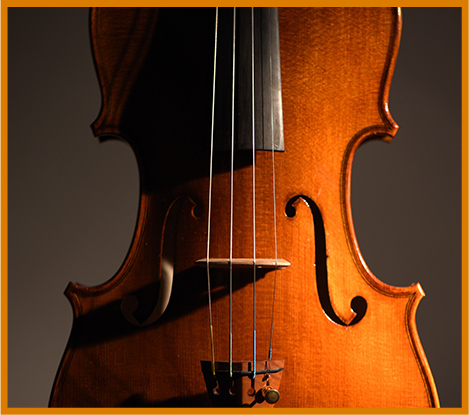
The theories from old Italian violins are applied to “CHACONNE” as contemporary instruments.
“CHACONNE” is combining brilliant sound in the high register and richer sound in the mid-low register. Even further the structure of the body can make the sound be quite clear and pure while being heard up to a great distance in the concert hall, while the players play very naturally and easily without disturbing their performance.
Starting with the repair and restoration of great old string instruments, at the present time we were able to create the modern-day Stradivarius, the “CHACONNE”, because we are not bound by the standardized recipes that are considered to be common knowledge. We suggest that you try the innovative sounds.
Construction and Varnish

There are two distinguishing points that set “CHACONNE” instruments apart from other instruments by contemporary makers:
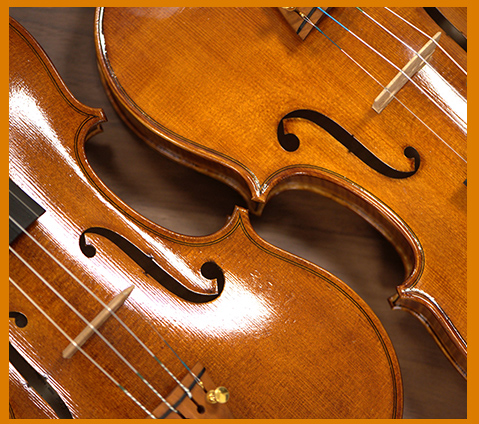
Construction
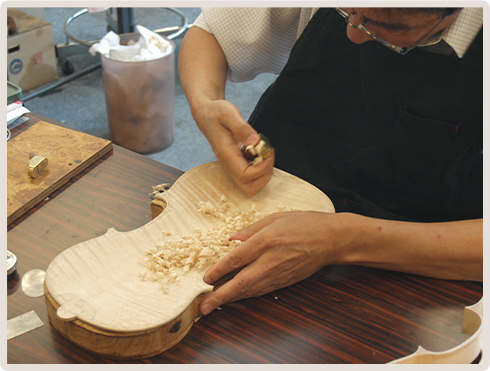
In the process of the repair and restoration of the great old Italian instruments, we aim to have them brought as close to the original state as possible.
After removing excess wood from patches inside, completing repairs such as reinforcement with Japanese paper and then resurrecting the old Italian instruments in a near original state, the strength has been kept evenly balancing the tone if we tap the surface of the body and check the pitch.
“CHACONNE” is made with a method to improve the strength balance by checking the pitch tapped on the surface of the body, based on the theory obtained during the restoration work of old Italian instruments.
Different from the theory of carving the arching inside and out while measuring the thickness which is commonly done in modern construction methods, we use a technique that balances pitch to improve the strength balance of the body. The entire body vibrates uniformly and the front and the back of the instrument resonates. This allows the instrument performance to be dramatically improved and the sound to echo and reach further away just by playing lightly.
In the era when Antonio Stradivari lived he had no tool to quickly and accurately measure the thickness of wood as is done in the present. In order to produce a large number of string instruments using wood with various characteristics, it is quite reasonable to carve the wood in this way, constantly keeping strength balance in mind by tapping the wood.
The structure of a “CHACONNE” is completely different from simply copying the appearance, size and thickness of the Stradivari. We aim for the sound to resemble a Stradivarius, not the shape. In fact, in a survey in 2011, it was found that the overtones of the Stradivari and the “CHACONNE” are very similar.

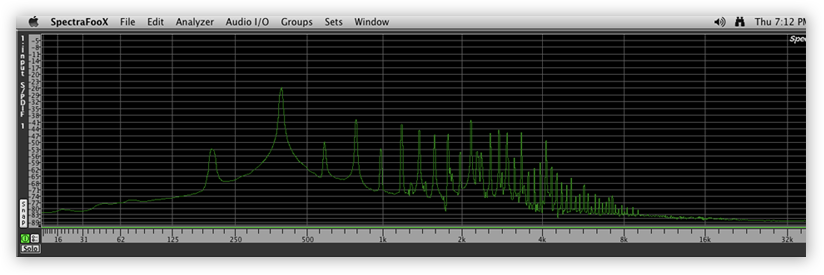
Also in 2017, when a Japanese popular TV program featured the Stradivari, it was discovered that the acoustic characteristics of the Stradivari also exist in a “CHACONNE.” The professor of acoustics who actually conducted research and analysis commented that “The resemblance between the Stradivari and the “CHACONNNE” is incredible!!.”
Varnish
It has long been said that “The secret to the sound of the Stradivari lies in the varnish.”
A team of experts from France and Germany announced that “the main ingredients of the varnish used on Stradivarius we reoil and rosin, which were actually common varnish materials in the 18th century.”
Even before this announcement, we focused on oil varnish and have continued to improve it through repeated research.

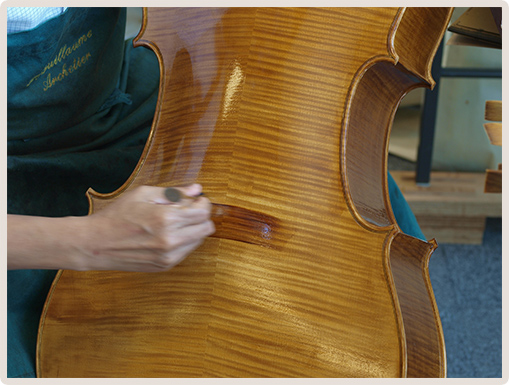
We use golden-yellow varnish made from drying oil and rosin for the ground to produce the rich sounds of mid-low tones. We apply dark red-brown varnish made from volatile oil and rosin for the surface. By using volatile oil, almost only rosin particles remain on the surface and it produces beautiful high frequency sounds. Applying these two kinds of varnish, not only does it look more like old Italian violins, but it also makes it possible to produce a richer and more beautiful sound.
International String Instrument Trade Fair
“CHACONNE” instruments has been exhibited in the “Mondomusica” in Cremona from 2009 to 2015, “Mondmusica 2013” in New York, “Music China” 2015 and 2016, and we participated as the only maker from Japan in the “Amati Exibition” which is just by selected dealers in Europe.
Luca Fanfoni and “CHACONNE”instruments
“CHACONNE” had been exhibited in the “Mondomusica”, which is the most famous international trade fair for stringed instruments held in Cremona every year.
Luca Fanfoni was amazed at its quality of our instruments which had the beautiful rich sound reminiscent of old Italian violins, then he made an offer for us to produce a concert tour in Japan using “CHACONNE” instruments with “Reale Concert Ensemble”, which has released numerous CDs with Fanfoni.
In 2012, the concert tour was held in seven locations in Japan, with performances of eleven “ CHACONNE” instruments.
Luca Fanfoni is one of the most famous violinists and condoctors in Italy. He is professer of the Parma Conservatory. He recorded many CDs and performed around the world. He also had many interesting projects, for example, the last CD “Rediscovery of Paganini played on Paganini’s violin”.
Six unpublished Paganini works, which were discovered by Luca Fanfoni and musicologist Dr.Danilo Prefumo, were recorded with the “Il-Cannone, Guarnerius of 1743” famously owned by Nicolo Paganini. He plays Paganini’s famous violin with brilliant technique and delicate sensibility, and is well received by the public.
Evaluation from Musicians
“CHACONNE” has been highly evaluated in performance by many musicians, not only for concerts by professional musicians, but also for entrance examinations for music colleges or studying abroad specially in Europe and America. Even international music competitions in Europe where not only technique but also musicality is required, the sound of this instrument caught the attention of the jurors and received rave reviews with the brilliant, rich, powerful and delicate sound.”CHACONNE” has the performance comparable to old violins.
Comments from Professional Performers
More than 500 people own and play “CHACONNE”.
Some of the owners are professional players. They describe “CHACONNE” as follows;
“The weight of the instrument is light like an old Italian violin. It’s possible to play powerfully without strength. I feel that the sound quality is similar to the Stradivari or it has even more loud. It’s easy to play in a variety of expressions, because the sound of “CHACONNE” is quite pure, not being biased.”
“The pianissimo resounds and echoes farthest side of the hall like the Stradivari.”
“When my Nicolo Gagliano had been repaired by CHACONNE, I borrowed a Guarneri del Gesu and used it in my recital. I had played my Gagliano for 25 years and been satisfied with it. However, after this experience, I felt a huge difference between a Guarneri and my Gagliano. I couldn’t forget the sound and feeling of use of a Guarneri. Then I tried a “CHACONNE” in the exhibition. I was very surprised to find that it had the same kind of sound, feeling of use as a Guarneri. At that moment, I decided to purchase this violin.”
Price
The price of CHACONNE instruments make them the best value for the money in the market. With violins under ¥2,000,000- and cellos under ¥4,000,000-, you can be assured to have an instrument that sounds like some of the best old Italian masterpieces at a price that is affordable.
窪田 博和
Hirokazu KUBOTA
Hirokazu Kubota was born in Nagoya in 1948. At the age of 14, Dvorak’s Symphonie No.9 with Bernstein and the New York Philharmonic on record awakened his interest in classical music. He wanted as many people as possible to enjoy classical music, so he went to Europe to buy instruments and learn techniques of repairing and restoring them.
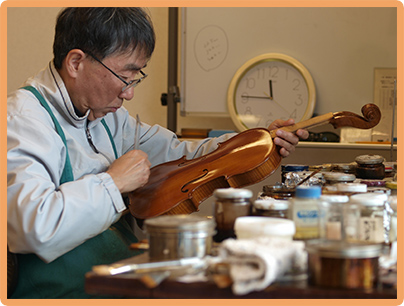
After returning to Japan, he started selling instruments in 1976, and established his own company in 1982. Since then, as a world-class dealer of violins, violas, cellos and bows, he has travelled all over the world to London, New York, Paris(the former centre of the violin market), Cremona, Mittenwald (a mecca for violinmaking), Beijing and Shanghai (the centre of violin making in recent years),handling a vast number of instruments.
Around 2007, he began to make new instruments, “CHACONNE”, and in 2009exhibited them at Mondomusica in Cremona.
He continues to re-examine and research traditional repair techniques and sound adjusting, and makes instruments based on his findings.



